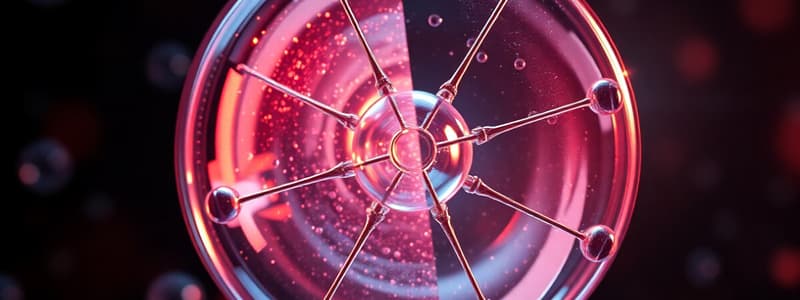Podcast
Questions and Answers
What significant feature distinguishes Rutherford's Nuclear Model from Thomson's Plum Pudding Model?
What significant feature distinguishes Rutherford's Nuclear Model from Thomson's Plum Pudding Model?
- Electrons are embedded within a positively charged medium.
- Atoms are considered to be positively charged spheres.
- Atoms contain a small dense nucleus in the center. (correct)
- Electrons are evenly distributed throughout the atom.
How did Bohr address the issue of electron stability in his atomic model?
How did Bohr address the issue of electron stability in his atomic model?
- By proposing that electrons can exist in any orbit around the nucleus.
- By claiming that electrons do not exist outside the nucleus.
- By asserting that all electrons have the same energy state.
- By suggesting that electrons occupy specific energy levels or shells. (correct)
What concept characterizes the Quantum Mechanical Model of the atom?
What concept characterizes the Quantum Mechanical Model of the atom?
- Electrons have well-defined paths around the nucleus.
- The atom is a solid sphere with no empty space.
- Electrons are described by probabilities and wave functions. (correct)
- Atoms have fixed positions that do not change.
Which statement is true about the formation of molecules as described in atomic theory?
Which statement is true about the formation of molecules as described in atomic theory?
What key observation did Rutherford make during his gold foil experiment?
What key observation did Rutherford make during his gold foil experiment?
What is the process called when a gas turns into a liquid?
What is the process called when a gas turns into a liquid?
What happens to molecules during the evaporation process?
What happens to molecules during the evaporation process?
What is the charge of a neutron?
What is the charge of a neutron?
In which part of an atom are protons located?
In which part of an atom are protons located?
Which subatomic particle carries a negative charge?
Which subatomic particle carries a negative charge?
What concept did early Greek philosophers propose about atoms?
What concept did early Greek philosophers propose about atoms?
According to Dalton's atomic theory, what is true about matter?
According to Dalton's atomic theory, what is true about matter?
What occurs during the cooling process of a substance?
What occurs during the cooling process of a substance?
Flashcards
Evaporation
Evaporation
The process where liquid turns into gas as molecules gain energy.
Melting
Melting
The change of a solid into a liquid when heated.
Condensation
Condensation
The process where gas turns into liquid as it cools.
Proton
Proton
Signup and view all the flashcards
Neutron
Neutron
Signup and view all the flashcards
Electron
Electron
Signup and view all the flashcards
Dalton's Atomic Theory
Dalton's Atomic Theory
Signup and view all the flashcards
Subatomic Particles
Subatomic Particles
Signup and view all the flashcards
Atomic Theory
Atomic Theory
Signup and view all the flashcards
Thomson's Plum Pudding Model
Thomson's Plum Pudding Model
Signup and view all the flashcards
Rutherford's Nuclear Model
Rutherford's Nuclear Model
Signup and view all the flashcards
Bohr's Model
Bohr's Model
Signup and view all the flashcards
Quantum Mechanical Model
Quantum Mechanical Model
Signup and view all the flashcards
Study Notes
Phase Changes in Matter
- Evaporation: Liquid changes to gas. Molecules on the surface gain enough energy (usually from heat) to escape the liquid.
- Melting: Solid changes to liquid. Particles gain enough energy to overcome the forces holding them in a fixed position, allowing them to move more freely.
- Condensation: Gas changes to liquid. Molecules lose energy as they slow down and move closer together, forming a liquid.
- Heating: Adding heat increases particle energy. This can lead to changes of phase, like melting or evaporation.
Sub-atomic Particles of an Atom
- Proton: Positively charged subatomic particle. Symbol (p or p+). Mass approximately 1.6726 x 10-27 kg. Located in the nucleus.
- Neutron: Neutral subatomic particle. Symbol (n or n0). Mass is similar to proton. Located in the nucleus.
- Electron: Negatively charged subatomic particle. Symbol (e or e-). Very small mass (approximately 9.109 x 10-31 kg). Located outside the nucleus in orbitals (electron cloud).
Atomic Models
- Dalton's Atomic Theory (Early 1800s): All matter is made of indivisible atoms. Atoms of the same element have identical masses and properties.
- Thomson's Plum Pudding Model (1899): Negatively charged electrons are embedded in a sphere of positive charge.
- Rutherford's Nuclear Model: Most of an atom's mass is concentrated in a small, positively charged nucleus. Negatively charged electrons orbit the nucleus.
- Bohr's Model (1913): Electrons orbit the nucleus in specific energy levels or shells. Electrons absorb or emit energy when transitioning between these levels.
- Quantum Mechanical Model (1920s): Electrons do not follow precise orbits but exist in orbitals within an electron cloud. The exact location of an electron cannot be determined precisely.
Periodic Table
- The periodic table organizes elements based on their similarities in properties.
- Elements with similar properties are grouped together.
Studying That Suits You
Use AI to generate personalized quizzes and flashcards to suit your learning preferences.




